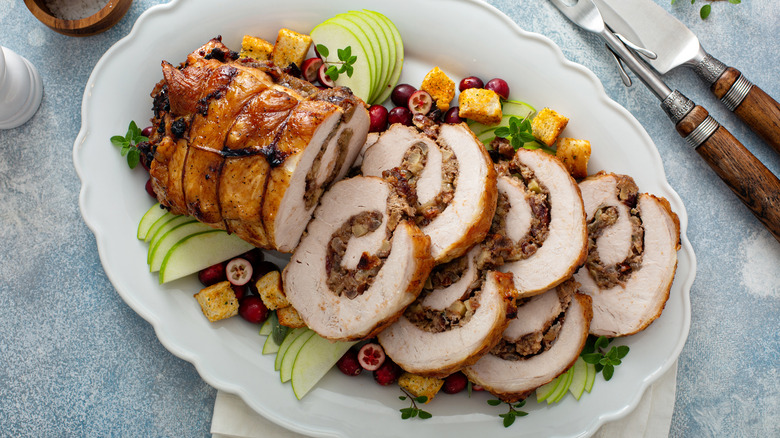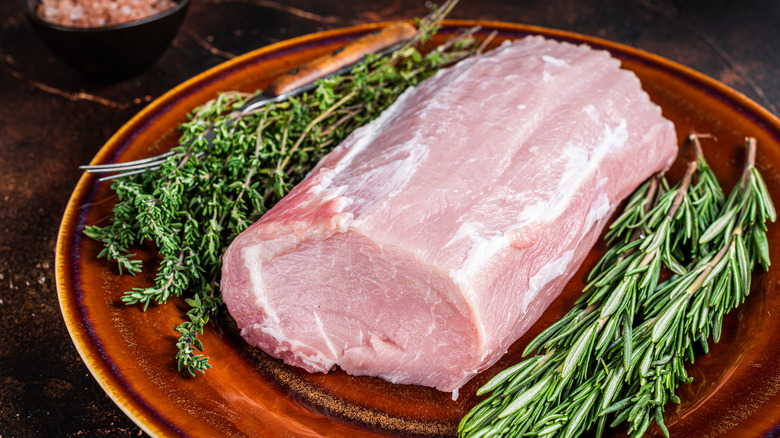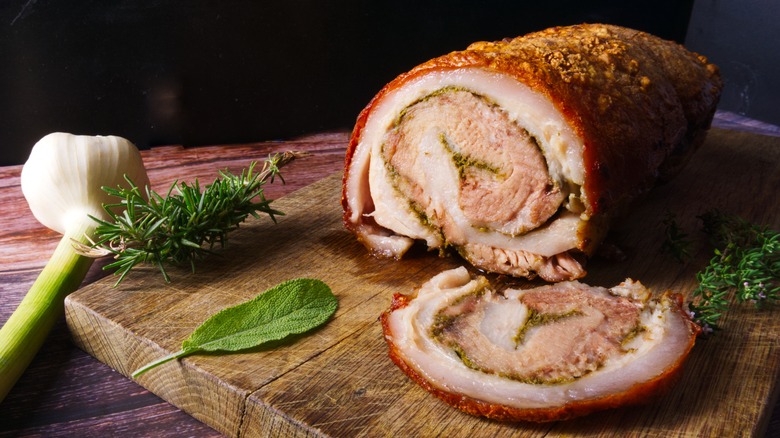Want Perfectly Stuffed Pork Loin? Butterfly It First
The butterfly cut has a reputation for being a little fiddly. One slip of the knife, and you've cut your meat in two. However, if you're planning on stuffing a pork loin, butterflying is not only the best way to maximize the flavor of this dish, but it's also incredibly easy — especially when compared to butterflying a chicken, which takes time and no small amount of skill.
In short, there's one key reason why a butterfly cut works so well for stuffed pork loin: It transforms a once-thick cylinder of pork into a thinner, more malleable piece of meat. Doing this offers several benefits for when you move on to stuffing your pork loin.
Firstly, butterflying ensures your meat is a relatively consistent thickness throughout. If you simply slice down the middle of your pork instead, you'd end up with two semicircular half-loins with substantially thicker meat in their centers than their edges. The butterfly cut avoids this issue, allowing heat to distribute evenly throughout the meat as it cooks.
Second, butterflying hugely increases the surface area of your pork, allowing you to evenly distribute your filling. This has two benefits: It makes it easier to prevent overstuffing or understuffing your loin, and it lets you get your delicious filling into contact with as much meat as possible. As the loin cooks, the moisture and flavor from your filling will transfer to the meat it's in contact with, so more surface area means a more flavourful, moist loin.
How to butterfly a pork loin (the easy way and the perfect way)
There are two common techniques for butterflying a pork loin. The first is more or less foolproof, but you won't quite end up with a perfectly even sheet of pork. For this method, with a sharp knife simply cut lengthways along the center of your pork loin, leaving just enough room so that you don't cut through to the other side. Once you've cut from end to end of the loin, you gently open it up like a book and press the two sides down gently to flatten them a little, taking care not to break the thin piece of linking meat holding the two sides together.
The second method takes only a little bit more finesse, but it's worth it. Instead of cutting along the loin in the middle, make your cut about ⅓ of the width across, still taking care not to cut right through to the other side. When you've done this, let the smaller side fold open and lay it flat on your cutting board. Then slice into the larger ⅔ piece that remains, moving across horizontally, in line with the cutting board. As you do this, gently peel back the remaining part of the loin so you can keep cutting the same thickness as it unrolls.
Once you've added your stuffing, you simply roll the pork loin back up like a savory jelly roll, tie it with twine in a few places, and it's ready to cook!
Beyond stuffed pork loin
While the butterfly cut is the ideal approach for preparing a stuffed pork loin, it's also useful for several other pork dishes. Since butterflying is mainly about creating that nice even surface of meat, it's a good technique to use for a pork stir fry. Once your butterflied pork is laid out flat, it's easy to cut nice slices of an even thickness and size. Prepare to level up your homemade moo shu pork game.
Also, a butterfly cut is a nice way to elevate homemade porchetta. Here, what adds value is the surface area, bringing loads of pork flesh into contact with rosemary, garlic paste, and any other less traditional fillings you might want to add.
Finally, a butterfly cut can be an end in itself. Once flattened out, you can marinade your whole butterflied pork tenderloin, then sear in the pan and finish in the oven, just like you'd do with a rolled stuffed pork loin. However, the magic here is that because the pork you're cooking is cut thin and left flat, it takes a fraction of the time to cook. It's perfect when you're short on time in an evening — just remember to marinate it ahead of time!


